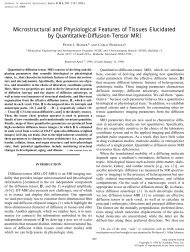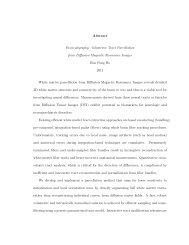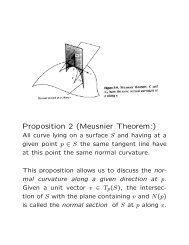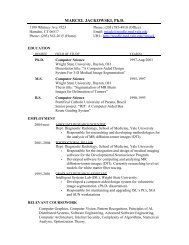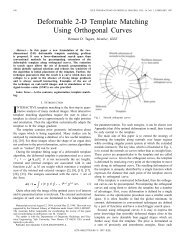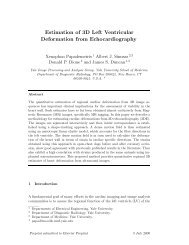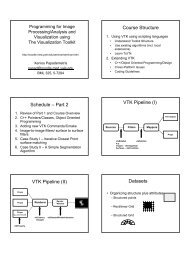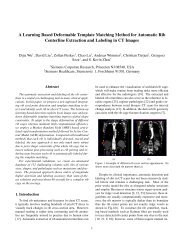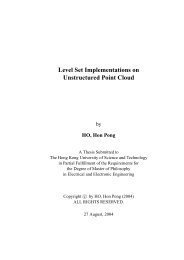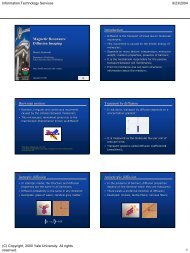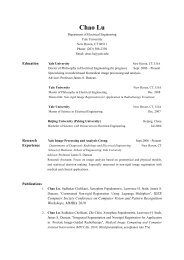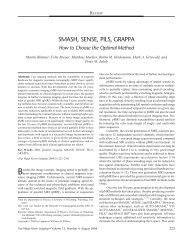Pulsed-field gradient nuclear magnetic resonance as a tool for ...
Pulsed-field gradient nuclear magnetic resonance as a tool for ...
Pulsed-field gradient nuclear magnetic resonance as a tool for ...
You also want an ePaper? Increase the reach of your titles
YUMPU automatically turns print PDFs into web optimized ePapers that Google loves.
224<br />
PRICE<br />
Table 7 Summary of Gradient Calibration Methods<br />
Method Range of Application ProsCons<br />
Coil calculation Unlimited Generally applicable<br />
Can be complicated to per<strong>for</strong>m<br />
Not very accurate<br />
Echo shape gl2 receiver bandwidth Generally applicable<br />
signal-to-noise Numerous systematic errors<br />
1D Image gl2 receiver bandwidth Generally applicable<br />
signal-to-noise In<strong>for</strong>mation on <strong>gradient</strong> linearity<br />
Gradient pulse mismatch Similar to echo shape Similar to echo shape<br />
Standard sample Need to have a relevant Simple<br />
standard Includes <strong>gradient</strong> non-ideality<br />
Few suitable and accurate standards<br />
Need accurate temperature control<br />
sion coefficients are listed in Table 8. Apart from<br />
sample-dependent problems, the effects of eddy<br />
currents andor mechanical vibrations, if present,<br />
will result in this method giving only an apparent<br />
calibration. If the sample experimental conditions<br />
Ži.e., sample shape, delays, pulse lengths, <strong>gradient</strong><br />
strengths, etc. . are used in a subsequent experiment,<br />
this calibration procedure h<strong>as</strong> the advantage<br />
of automatically including nonideal <strong>gradient</strong><br />
behaviour. However, because eddy current effects<br />
incre<strong>as</strong>e with <strong>gradient</strong> strength, a calibration at<br />
one current value cannot be used to determine<br />
the <strong>gradient</strong> strength at another value of the<br />
applied current. This method of <strong>gradient</strong> calibration<br />
is further limited by the need to have a<br />
compound containing a nucleus that can be observed<br />
with the probe at hand and with a similar<br />
diffusion coefficient and excellent temperature<br />
control. Clearly, a multi<strong>nuclear</strong> probe gives the<br />
most possibilities. For lower diffusion coefficients,<br />
suitable reference compounds become more<br />
scarce. Glycerol h<strong>as</strong> often been used <strong>as</strong> a reference,<br />
but its diffusion coefficient is greatly affected<br />
by water content <strong>as</strong> well <strong>as</strong> a highly temperature-dependent<br />
diffusion coefficient and T2 Ž 4, 102 . .<br />
Shape Analysis of the Spin-Echo and<br />
One-Dimensional Images<br />
It is possible to calculate the <strong>gradient</strong> strength<br />
using the echo shape from a sample of known<br />
geometry. This is e<strong>as</strong>y to understand if you consider<br />
that in the absence of a <strong>gradient</strong> there is no<br />
spatial dependence of the <strong>resonance</strong> frequency,<br />
but in the presence of a <strong>gradient</strong> there is a spatial<br />
dependence. Thus, the observed FID and spectrum<br />
will reflect both the <strong>gradient</strong> and the shape<br />
Table 8 Some Selected Reference Compounds and Their Diffusion Coefficients at 298 K Useful <strong>for</strong><br />
Calibrating PFG Experiments<br />
Diffusion 2 1<br />
Ž .<br />
Observe Nucleus Compound Coefficient m s Reference<br />
1 9 H H O 2.30 10 Ž 118, 119.<br />
2<br />
2 2 9 H H O 1.87 10 Ž 120.<br />
2<br />
2 2<br />
9<br />
HO H in H 2O<br />
1.90 10<br />
7 Ž . 10<br />
Li LiCl 0.25 M in H O 9.60 10 Ž 102.<br />
2<br />
13 9 C C H 2.21 10 Ž 81.<br />
6 6<br />
19 9 F C H F 2.40 10 Ž 102.<br />
6 6<br />
21 2 Ž . 9<br />
Ne Ne 4 MPa in H O 4.18 10 Ž 121.<br />
2<br />
23 Ž . 9<br />
Na NaCl 2 M in H O 1.14 10 Ž 122.<br />
2<br />
31 Ž . Ž . 10<br />
P C H P 3 M in C D 3.65 10 Ž 102.<br />
6 5 3 6 6<br />
129 Ž . 9<br />
Xe Xe 3 MPa in H O 1.90 10 Ž 123.<br />
2<br />
133 Ž . 9<br />
Cs CsCl 2 M in H O 1.90 10 Ž 102.<br />
2<br />
A more comprehensive listing can be found in Holz and Weingartner ¨<br />
Ž 102 . .



